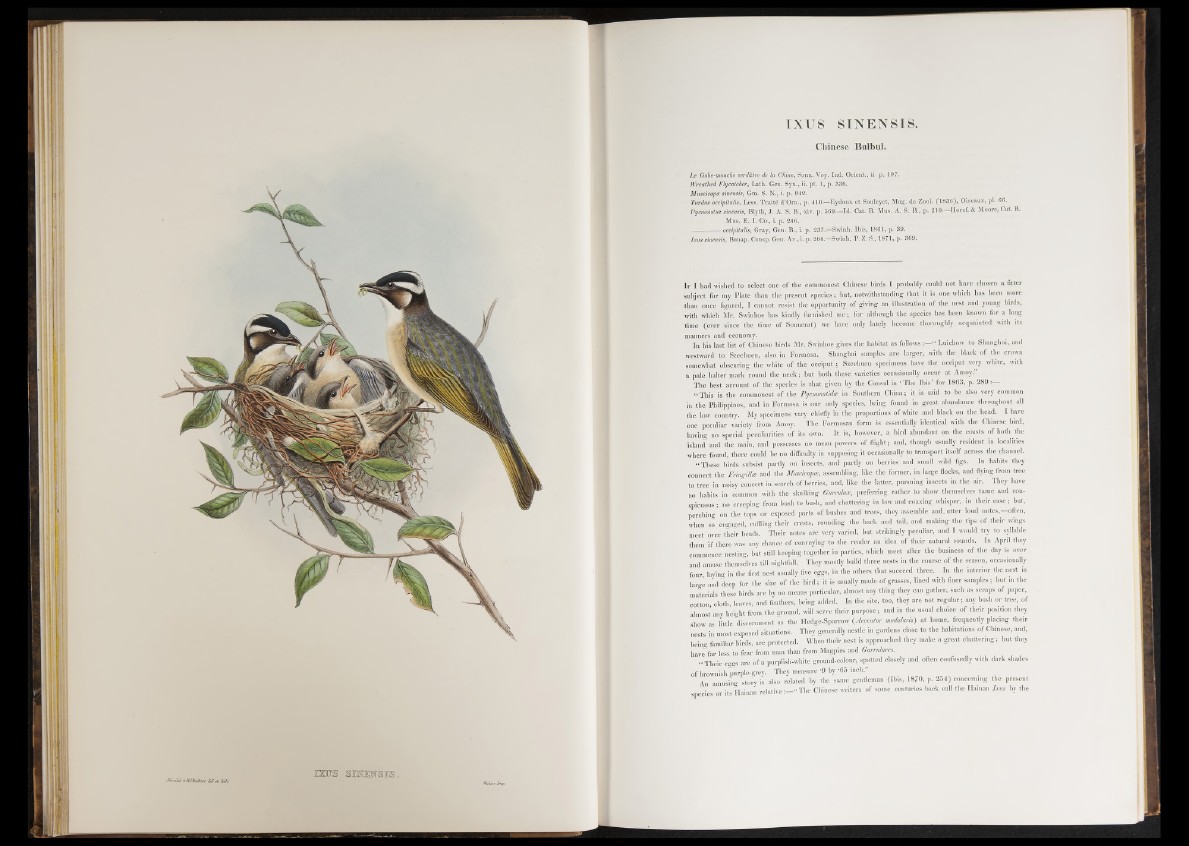
IXUS SINENSIS.
Chinese Bulbul.
Le Gobe-mouche verdâtre de la Chine, Sonn. Voy. Ind. Orient., ii. p. 197. .
Wreathed Flycatcher, Lath. Gen. Syn., ii. pt. 1, p. 336,
Muscicapa sinensis, Gm. S. N., i. p. 942.
Turdus occipitalis, Less. Traité d’Orn., p. 410.—Eydoux et Souleyet, Mag. de Zool. (1836), Oiseaux, pi. 66.
Pÿcmnotus sinensis, Blyth, j . A. S. B., xiv. p. 569— Id. Cat. B. Mus. A. S. B., p. 210— Horsf. & Moore, Cat. B.
MusA/E. I. Co., i. p. 246.
ÎJLtJrJ Gray, Gen. B., i. p. 237/.EAlwin.h. Ibis, 1861, p. 39.
Jeus sinensis, Bonap. Consp. Gen. Av., i. p. 266. Swinii. P. Z. S., 1871, p. 369.
I r I had wished to select one of the commonest Chinese birds I probably could not have chosen a fitter
subject for my Plate than the present species; but, notwithstanding that it is one which has been more
than once figured, I cannot- resist the opportunity of giving an illustration of the nest and young birds,
with which Mr. Swinhoe has kindly furnjshed me; for although the species has been known for a long
time (ever since the time of Sonnerat) we have only lately become thoroughly acquainted with its
manners and economy.
In his last list of Chinese birds Mr. Swinhoe gives the habitat as f o l l o w s “ Luichow. to Shanghai, and
Westward to Szechuen, also in Formosa. Shanghai samples, are. larger, with the black of the crown
somewhat obscuring, the white of the. occiput; Szechuen specimens have the occiput very white, with
a pale halter mark round the neck; .but both these varieties occasionally occur at Amoy.” ..
The best account of. the 'species is thSfc given by the. Consul in ‘ The Ibis ’ for 1863, p. 2 8 9 r
“ This is the commonest of the Pycnomiidce in Southern China; it is said, to be also very common
in the Philippines, and in Formosa is our only species, being found in great, abundance throughout all
the ldw country. My specimens vary chiefly in the proportions of white and black on the head. I have
one peculiar variety from Amoy. The Formosan form is essentially identical with the Chinese bird,
having ms isgecial peculiarities of its own. It is, however, a bird abundant on the coasts of both the
island and the main, and possesses no mean powers of flight; and, though usually resident in localities
where found, there could be ho difficulty in supposing it occasionally to transport itself across the channel.
“ These birds subsist partly on insects, and partly (in berries and small wild figs. In habits they
connect the Frmgillre and the Muscícapa, assembling, like the former, in large flocks, and flying from tree
to tree in noisy concert in search of berries, and, like the latter, pursuing insects in the air. They have
no habits in common with the skulking Garrulm, preferring rather to show themselves tame and conspicuous
; no creeping from bush to bush, and chattering in low and coaxing whisper, in their c a se ; but,
perching’ on the tops or exposed parts of hushes and trees, they assemble and. utter loud notes,—often,
when so engaged, rnffling their crests, rounding the back and tail, and making the tips of their wings
meet over their heads. Their notes are very varied, but strikingly peculiar, and I would try to syllable
them if there was any chance of conveying to the reader an idea o f tbeir natural sounds. In April they
commence nesting, but still keeping together in parties, which meet after the business of the day is over
and amuse themselves till nightfall. They mostly build three nests in the course of the season, occasionally
four laying in the first nest usually five eggs, in the others that succeed three. In the interior the nest is
large and deep for the size of t h s t i r d ; it is usually made of grasses, lined with finer samples; but in the
materials these birds are by no means particular, almost any thing they can gather, such as scraps of paper,
cotton cloth, leaves, and feathers, being added. In the site, too, they are not regular; any bush or tree, of
almost any height from the ground, will serve their purpose; and in the usual choice of their position they
show as little discernment as the Hedge-Sparrow (Accentor modularle) at home, frequently placing their
nests in most exposed situations. They generally nestle in gardens icjqse to the habitations of Chinese, and,
being familiar birds, are protected. When their nest is approached they make a great chattering; but they
have far less to fear from man than from Magpies and Ganulaces.
1 Their eggs are o f a purplish-white ground-colour, spotted closely and often confusedly with dark shades
o f brownish purple-grey. They measur e-9 b y -65 inch.”
An amusing story is also related by the same gentleman (Ibis, 1870, p. 254) concerning the present
speeies or its Hainan r e l a t i v e T h e Chinese writers of some centuries back call the Hainan Ixus by the